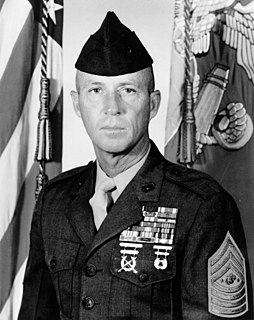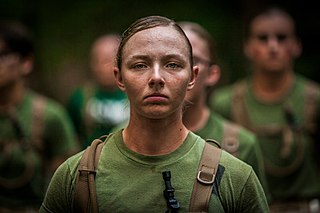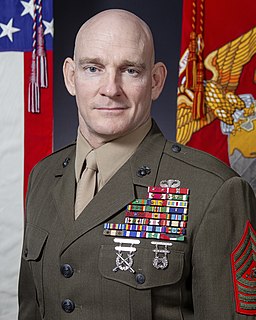
Military recruit training, commonly known as basic training or boot camp, refers to the initial instruction of new military personnel. It is a physically and psychologically intensive process, which resocializes its subjects for the unique demands of military employment.

Marine Corps Recruit Depot Parris Island is an 8,095-acre (32.76 km2) military installation located within Port Royal, South Carolina, approximately 5 miles (8.0 km) south of Beaufort, the community that is typically associated with the installation. MCRD Parris Island is used for United States Marine Corps Recruit Training of enlisted United States Marines. Recruits living east of the Mississippi River report there to receive initial training. Recruits living west of the Mississippi River receive training at Marine Corps Recruit Depot San Diego, California, but may train at MCRD Parris Island by special request.

A drill instructor is a non-commissioned officer in the armed forces, fire department, or police forces with specific duties that vary by country. Foot drill, military step, and marching are typically taught by drill instructors.

Marine Corps Recruit DepotSan Diego is a United States Marine Corps military installation in San Diego, California. It lies between San Diego Bay and Interstate 5, adjacent to San Diego International Airport and the former Naval Training Center San Diego. MCRD San Diego's main mission is the initial training of enlisted male and female recruits living west of the Mississippi River. Over 21,000 recruits are trained each year. As of 2022, 1.5 million recruits have completed their boot camp training at the Depot. The Depot also is the home to the Marine Corps' Recruiter School and Drill Instructors School.
The School of Infantry (SOI) is the second stage of initial military training for enlisted United States Marines after recruit training. Since the initial training pipeline is divided between coasts, Marines from areas east of the Mississippi River usually graduate from MCRD Parris Island and move on to SOI at SOI East, while those from the western half of the nation attend MCRD San Diego and move on to SOI West at the Camp San Onofre area of Camp Pendleton in California. Female Marines are trained at both SOI East and SOI West. The School of Infantry's training mission ensures "Every Marine is, first and foremost, a Rifleman". At SOI, Marines with the Military Occupational Specialty of infantry are trained at the Infantry Training Battalion (ITB), while all non-infantry Marines are trained in basic infantry and combat skills at the Marine Combat Training Battalion. SOI marks a transition in the professional training of entry-level students from basically trained Marines to combat-ready Marines.

Edson Range is a firing range complex at Marine Corps Base Camp Pendleton, near Oceanside, California. It is named for Marine Major General "Red Mike" Edson, "a World War II Medal of Honor recipient and a distinguished small arms marksman proponent." This rifle-qualification complex is home to four of the largest firing ranges on the base. The range became operational on August 21, 1964, the same day that Camp Calvin B. Matthews, in La Jolla, California, was closed and turned over to the University of California. Camp Matthews had previously been used for rifle training.

Lewis G. Lee is a retired United States Marine who served as the 13th Sergeant Major of the Marine Corps from 1995 to 1999. He retired from active duty in 1999 after over 31 years of service. He was the last Sergeant Major of the Marine Corps to serve in combat in the Vietnam War.

Harold G. Overstreet is a retired United States Marine who served as the 12th Sergeant Major of the Marine Corps from 1991 to 1995.

David W. Sommers is a retired United States Marine who served as the 11th Sergeant Major of the Marine Corps from 1987 to 1991.

John R. Massaro is a retired United States Marine who served as the 8th Sergeant Major of the Marine Corps from 1977 to 1979.

Carlton Wayne Kent is a retired United States Marine who served as the 16th Sergeant Major of the Marine Corps. He succeeded John L. Estrada on April 25, 2007, and was succeeded by Micheal Barrett on June 9, 2011.

United States Marine Corps Recruit Training is a 13-week program, including in & out-processing, of recruit training that each recruit must successfully complete in order to serve in the United States Marine Corps.
Ears, Open. Eyeballs, Click is a 2005 documentary film by Canaan Brumley, about the experiences of Marine recruits during bootcamp. Unlike many documentaries, this film offers no narration nor a focus on central characters, shooting from a fly-on-the-wall perspective. Despite this unusual approach, the film has received very positive reviews overall, especially from film festivals, such as the Los Angeles Film Festival and the San Diego Film Festival.

Justin D. LeHew is a United States Marine who served in the War on Terror. He was awarded the Navy Cross for his actions on 23 and 24 March 2003 during the initial 2003 invasion of Iraq. He was hand picked to spearhead the rescue operation and recovery of the U.S. Army's 507th Maintenance Company on 23 March and subsequently was called upon again to take part in the rescue operation of US Army Private Jessica Lynch on 1 April 2003. He is also a recipient of the Bronze Star with Combat Distinguishing Device denoting Valor for his heroic actions from 5 to 28 August 2004 during the Battle of Najaf.

The 3rd Recruit Training Battalion is composed of four training companies; India, Kilo, Lima and Mike. The recruit training battalion is responsible ensuring that each company is following the procedures set forth by the Recruit Training Regiment. Each company is responsible to follow the standards established by the Commandant of the Marine Corps to train, teach, mentor, and above all lead recruits through a demanding standard-based training system. 51% of all male Marines attend recruit training at Marine Corps Recruit Depot, San Diego, California.

The Marine Recruit Training Regiment San Diego (MCRDSD), based at San Diego, California, is a training regiment of the United States Marine Corps. It is composed of three recruitment battalions and three recruit training battalions: 1st, 2nd, 3rd. Each battalion is responsible for ensuring that each company within it is following the procedures set forth by the Recruit Training Regiment. The West Coast depot is in charge the basic training of all male candidates who join the Marine Corps from the west of the Mississippi
The 1st Recruit Training Battalion is a battalion of the United States Marine Corps which is used to train new enlisted personnel. It is composed of four Training Companies; Alpha, Bravo, Charlie, and Delta. The recruit training battalion is responsible for ensuring that each company is following the procedures set forth by the Recruit Training Regiment. Each company is responsible to follow the standards established by the Commandant of the Marine Corps to train, teach, mentor, and above all lead recruits through a demanding standard-based training system. 51 percent of all male Marines attend recruit training at Marine Corps Recruit Depot San Diego (MCRDSD), California."

There have been women in the United States Marine Corps since 1918, and women continue to serve in the Corps today. As of 2020, women make up 8.9% of total active duty Marines. These numbers give the Marine Corps the lowest ratio of women in all of the U.S military branches. Women's presence in the Marine Corps first emerged in 1918 when they were permitted to do administrative work in an attempt to fill the spots of male Marines fighting overseas. It was not until 1948 that women were able to become a permanent part of the Corps with the passing of the Women's Armed Services Integration Act. However, even with the Integration Act, women were still banned from certain military occupation specialties. It was not until 2016 that Defense Secretary Ash Carter announced that all military occupations would be open to women without exception. As of 2018, there were 18 women serving in the Marine Corps combat arms. In December 2020, the Marine Corps Recruit Depot San Diego agreed to join the Marine Corps Recruit Depot Parris Island in accepting female recruits, with 60 female recruits starting their boot camp training at the San Diego depot in February 2021. 53 of these recruits would successfully graduate from boot camp in April 2021 and become Marines.
Stephen A. Cheney is a retired United States Marine Corps Brigadier General who served for more than 30 years. He is a graduate of the United States Naval Academy, and held command positions at the Marine Corps Recruit Depots in San Diego and Parris Island, where he was Commanding General. He also served as Inspector General of the Marine Corps from 1997 to 1999, during which time he was also Deputy Inspector General for the Department of the Navy. He retired from active duty in 2001. Cheney is currently President of the American Security Project.

Troy E. Black is a United States Marine and the 19th and current Sergeant Major of the Marine Corps as of July 26, 2019.

















